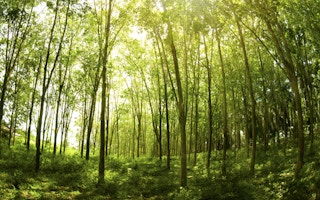WASHINGTON, DC – Global trends are reshaping how businesses approach sustainability. On one hand, consumers and investors are pushing businesses to raise their standards. On the other hand, technological shifts are generating more and better information faster, enabling unprecedented levels of transparency and accountability.
To continue reading, subscribe to Eco‑Business.
There's something for everyone. We offer a range of subscription plans.
- Access our stories and receive our Insights Weekly newsletter with the free EB Member plan.
- Unlock unlimited access to our content and archive with EB Circle.
- Publish your content with EB Premium.
Nowhere is this clearer then when it comes to management of the world’s forests.
Forests are a vital resource. But, today, they are under tremendous pressure, owing to growing demand for food, fuel, and fiber. Over the past 13 years, the world has lost an average of 50 soccer fields of forests every minute. Poor quality, out-of-date information often poses challenges even for companies with the best intentions.
“
Traceability of certain key commodities – including palm oil, soy, and paper pulp – will determine the success of the overall anti-deforestation agenda
But times are changing. Many companies are shifting their attention to forests, making strong commitments and establishing clear expectations of their suppliers. For example, the Consumer Goods Forum, a group of more than 400 retailers, manufacturers, and other organizations, has pledged to mobilize resources to help achieve zero net deforestation by 2020. In order to meet this target and achieve their anti-deforestation commitments, several companies, including Nestlé, are moving toward fully traceable supply chains.
Traceability of certain key commodities – including palm oil, soy, and paper pulp – will determine the success of the overall anti-deforestation agenda. And achieving traceability will require implementation of best practices along the supply chain. Many companies have already taken steps to increase visibility within their supply chains. It is important now to go beyond company practices and embrace industry-wide traceability standards across these commodities.
Business leaders are motivated not only by their customers and investors, who are calling for greater accountability, but also by rising material risks to their operations. Reporting mechanisms, like CDP’s supply chain and forests programs, are encouraging business to disclose more information to the public. Companies are competing to develop better strategies to manage their risks and identify measures that will help the planet and their bottom line.
At the same time, the world has entered an era of astonishing technological progress. Cloud computing has slashed the time it takes to analyze massive and complex data sets. Satellites circle the globe sending back images many times a day. Global connectivity, through laptops and smart phones, means that people everywhere can get real-time information in their living rooms, board rooms, and in the palm of their hands.
All of these trends are converging around Global Forest Watch, a new dynamic, online monitoring and alert platform led by World Resources Institute and more than 40 partners. Drawing heavily on Google Earth Engine, which has powered the visualization of the world’s largest data set on forests, Global Forest Watch provides businesses with the latest information, enabling them to see how their operations affect forests and where they are falling short. All of this has become faster and cheaper than ever before.
Consider palm oil, one of the world’s most ubiquitous food crops – nearly half of all products sold in grocery stores contain it – and a $44 billion industry worldwide. While palm oil can be produced sustainably, its production is currently a major driver of deforestation in Indonesia, Malaysia, and other tropical countries.
Now, with Global Forest Watch, companies that produce and use palm oil will be able to demonstrate that their products do not contribute to deforestation. Buyers and traders can quickly detect forest clearing and determine if it is legal and appropriate. They can then take action, including suspending the supplier, if needed.
This is just the beginning. New satellites currently being tested will gather images at even higher resolution. Mobile applications are being created for people to collect and distribute better information and mobilize action.
Businesses are not the only beneficiaries. Governments are finding new ways to track policies and strengthen enforcement, and communities that depend on forests will be able to see more easily what is happening in their surroundings and alert others. And all three – businesses, governments, and communities – can work collectively to create practical strategies and incentives that will assist forested countries to conserve their natural assets and meet their goals for economic development.
In a world where news about natural resources is often bleak, these developments offer new hope. Gone are the days when businesses and governments simply lacked the information to make sound decisions. Bad actors can be held accountable, and good ones can be encouraged to do even better. In this new era, business as usual is no longer good business.
Andrew Steer is president and CEO of World Resources Institute. Paul Bulcke is CEO of Nestlé SA, and co-chair of the Consumer Goods Forum. This post originally appeared in Project Syndicate. Copyright: Project Syndicate, 2014.









